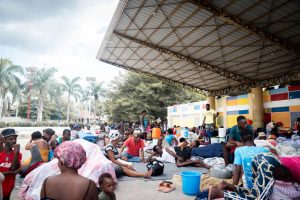Gang Violence and Mass Displacement Ravage Haiti
 22 September 2024
22 September 2024

Families residing in a makeshift displacement camp located in the main square of Leogane, Haiti. Credit: UNICEF/Le Lijour
By Oritro Karim
UNITED NATIONS, Sep 21 2024 (IPS)
Amid the ongoing civil unrest in Haiti due to gang violence, levels of internal displacement have soared. Mass internal displacements in Haiti have led to a host of adverse consequences. This includes a disruption of schooling, increased levels of violence and exploitation, and limited access to essential services such as healthcare.
Just last week, clashes in the Cité Soleil and Delmas neighborhoods of the Port-au-Prince metropolitan area have led to the displacement of over 2,000 people in the span of two days. As of now, over 170,000 people are displaced in Port-au-Prince alone, with over 300,000 displaced in the entire country.
On September 11th, armed clashes in Port-au-Prince forced over 103,000 children to flee to the Grand South displacement shelters. This influx of refugees has put a significant strain on local communities and shelters as they struggle to provide resources to those in need. In addition, the education system has been severely compromised, with Haiti seeing hundreds of school closures.
“The arrival of 103,000 displaced school-aged children in the Grand South has caused a severe strain on educational services while nationwide, nearly 919 schools in the West and Artibonite regions have been closed. Approximately 156,000 students have been affected, and many children have lost a substantial portion of their academic year due to these closures and ongoing violence”, stated the United Nations Children’s Fund (UNICEF).
Armed gang violence and mass displacement have also led to the dwindling efficacy of several essential services. Specifically, healthcare systems have seen significant losses. Approximately 40 percent of all healthcare facilities in Port-au-Prince have been shut down.
Reginald Fils-Aimé, director of strategic planning at the Haiti-based Zanmi Lasante non-government organization, told reporters that persistent gang violence impedes transportation for both healthcare staff and patients. Medicines cannot be transported due to fear of violence. Nadesha Mijoba, country director of the Haitian Health Foundation (HHF), adds that “patients are walking farther distances in search of health services, oftentimes, at very high risks of violence, kidnapping, rape, and even being killed”.
Additionally, access to food has been severely limited as a result of conflict and displacement. Violence and heavy demand has put a significant strain on the agricultural sector. The World Food Programme states that farmlands in the Arbonite Valley, also known as Haiti’s “breadbasket”, have been seized by gangs, leading to stolen crop yields.
The Food and Agriculture Organization if the United Nations (FAO) has warned that since February, the escalating violence and displacement has significantly reduced agricultural production and disrupted the markets. This has left half the population, approximately five million people, experiencing acute hunger.
Severe overcrowding in makeshift displacement camps have exacerbated the health crisis in Haiti. These camps are breeding grounds for the spread of disease due to unhygienic living conditions, as well as the sheer amount of people that are in close contact. UNICEF states that a lack of access to clean water and adequate sanitation has led to the spread of cholera.
Healing Waters International, a non-profit organization that is dedicated to bringing clean drinking water to impoverished communities, adds that contaminated water and dehydration often leads to the contraction of deadly waterborne diseases, including typhoid and diarrhea.
Gang violence and high levels of displacement have also made way for abuse and exploitation. The Human Rights Service of the UN Integrated Office in Haiti (BINUH) has monitored levels of forced recruitment of displaced children as well as gang use of sexual violence, including rape and mutilation, targeted towards girls and women. Kidnappings, killings, and physical assaults have also skyrocketed in the duration of this conflict.
IPS UN Bureau Report
